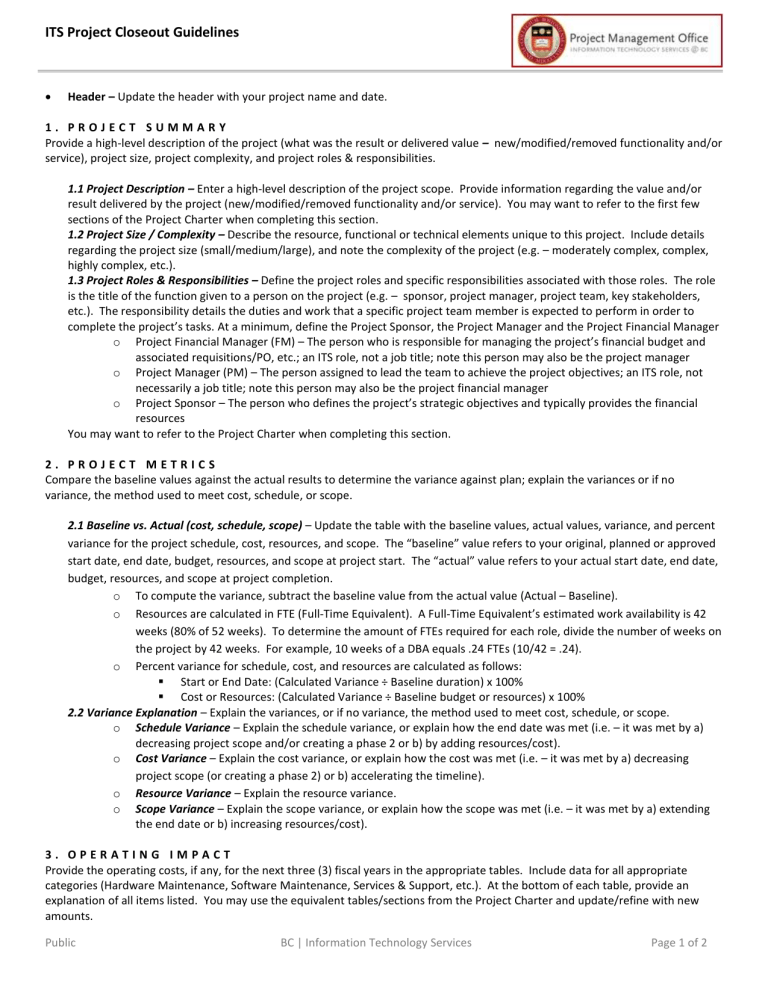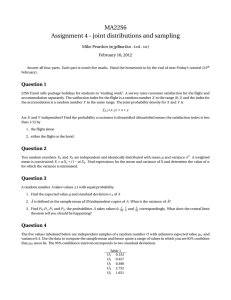ITS Project Closeout Guidelines

ITS Project Closeout Guidelines
Header – Update the header with your project name and date.
1 .
P R O J E C T S U M M A R Y
Provide a high-level description of the project (what was the result or delivered value – new/modified/removed functionality and/or service), project size, project complexity, and project roles & responsibilities.
1.1 Project Description – Enter a high-level description of the project scope. Provide information regarding the value and/or result delivered by the project (new/modified/removed functionality and/or service). You may want to refer to the first few sections of the Project Charter when completing this section.
1.2 Project Size / Complexity – Describe the resource, functional or technical elements unique to this project. Include details regarding the project size (small/medium/large), and note the complexity of the project (e.g. – moderately complex, complex, highly complex, etc.).
1.3 Project Roles & Responsibilities – Define the project roles and specific responsibilities associated with those roles. The role is the title of the function given to a person on the project (e.g. – sponsor, project manager, project team, key stakeholders, etc.). The responsibility details the duties and work that a specific project team member is expected to perform in order to complete the project’s tasks. At a minimum, define the Project Sponsor, the Project Manager and the Project Financial Manager o Project Financial Manager (FM) – The person who is responsible for managing the project’s financial budget and associated requisitions/PO, etc.; an ITS role, not a job title; note this person may also be the project manager o Project Manager (PM) – The person assigned to lead the team to achieve the project objectives; an ITS role, not necessarily a job title; note this person may also be the project financial manager o Project Sponsor – The person who defines the project’s strategic objectives and typically provides the financial resources
You may want to refer to the Project Charter when completing this section.
2 .
P R O J E C T M E T R I C S
Compare the baseline values against the actual results to determine the variance against plan; explain the variances or if no variance, the method used to meet cost, schedule, or scope.
2.1 Baseline vs. Actual (cost, schedule, scope) – Update the table with the baseline values, actual values, variance, and percent variance for the project schedule, cost, resources, and scope. The “baseline” value refers to your original, planned or approved start date, end date, budget, resources, and scope at project start. The “actual” value refers to your actual start date, end date, budget, resources, and scope at project completion. o To compute the variance, subtract the baseline value from the actual value (Actual – Baseline). o Resources are calculated in FTE (Full-Time Equivalent). A Full-Time Equivalent’s estimated work availability is 42 weeks (80% of 52 weeks). To determine the amount of FTEs required for each role, divide the number of weeks on the project by 42 weeks. For example, 10 weeks of a DBA equals .24 FTEs (10/42 = .24). o Percent variance for schedule, cost, and resources are calculated as follows:
Start or End Date: (Calculated Variance ÷ Baseline duration) x 100%
Cost or Resources: (Calculated Variance ÷ Baseline budget or resources) x 100%
2.2 Variance Explanation – Explain the variances, or if no variance, the method used to meet cost, schedule, or scope. o Schedule Variance – Explain the schedule variance, or explain how the end date was met (i.e. – it was met by a) decreasing project scope and/or creating a phase 2 or b) by adding resources/cost). o Cost Variance – Explain the cost variance, or explain how the cost was met (i.e. – it was met by a) decreasing project scope (or creating a phase 2) or b) accelerating the timeline). o Resource Variance – Explain the resource variance. o Scope Variance – Explain the scope variance, or explain how the scope was met (i.e. – it was met by a) extending the end date or b) increasing resources/cost).
3 .
O P E R A T I N G I M P A C T
Provide the operating costs, if any, for the next three (3) fiscal years in the appropriate tables. Include data for all appropriate categories (Hardware Maintenance, Software Maintenance, Services & Support, etc.). At the bottom of each table, provide an explanation of all items listed. You may use the equivalent tables/sections from the Project Charter and update/refine with new amounts.
Public BC | Information Technology Services Page 1 of 2
ITS Project Closeout Guidelines
3.1 Estimate of Operating Expenditures and Funding – Provide the specific costs required for the on-going operation and maintenance of the assets/deliverables as well as the anticipated (proposed) funding source(s).
3.2 Estimate of Cost Savings – Summarize the anticipated savings (in dollars and/or staff) by implementing this project’s recommended solution; if replacing a system, what maintenance or headcount savings would occur?
3.3 Estimate of Support Resources – Estimate (in FTEs) the support staff, including their roles and specific department which will be required annually to support the new solution. A Full-Time Equivalent (FTE) estimated work availability is 42 weeks (80% of 52 weeks). To determine the amount of FTEs required for a specific department, divide the number of weeks required for support by 42 weeks. For example, 10 weeks of a DBA from Decision Support/ Dept Apps equals .24 FTEs (10/42 = .24).
4 .
O U T S T A N D I N G T A S K S
List the tasks or activities that still remain open and who is responsible for completing them. Include details regarding the task description, the person(s) to which the task is assigned, the current status of the task, and the targeted date to complete that task, in the table provided.
5 .
L E S S O N S L E A R N E D
Describe the knowledge or experience derived from this project; this will assist future projects doing similar work. It is most helpful to review these questions at the end of the project with the project team.
5.1 Lessons Learned – For each category (where applicable), describe what went well throughout the project and what could be improved for future projects or related work. o Project management – The application of knowledge, skills, tools and techniques to project activities to meet the project activities; collaboration and facilitation with project team, project sponsor and stakeholders. o Requirements definition and management – The identification and management of the measurable and complete set of conditions required to provide the new/modified/removed functionality and/or service of the project. o Scope definition and management – The identification and management of the full sum of products, services, and/or results of the project. o Schedule development and control – The planning and control of the project timeline. o Cost estimating and control – The identification and control of all costs associated with the project. o Human resource availability, team development, and performance – The availability of project resources and the ability of the project resources to work effectively as a team to achieve project goals. o Risk management – The identification and management of project risks, risk owners, risk response, etc. o Communication management – The planning, management, and effectiveness of project communications. o Stakeholder management – The planning and management of stakeholder expectations throughout the project. o Reporting – The ability to collect and provide valuable performance information (status reports, progress measurements, forecasts, etc.). o Quality planning and control – The planning and management required to ensure that the project fulfills all requirements; typically related to use cases and testing planning o Procurement planning and management – The planning and control of procurement processes from procurement documentation to contract closure. o Process improvement information – Information regarding how business or project related processes were improved or could have been improved. o Product-specific information – Information regarding the artifact that is produced, or end result of the project. o Other – Any areas, other than those listed above, where project work went well or could be improved for future projects.
5.2 Quality Defects – List any quality defects with a description, resolution, and any related comments.
5.3 Vendor Management – Describe any issues or lessons learned when working with a particular vendor during the project, as well as the resolution and/or any additional comments.
5.4 Other – Note any particular areas on the project where the team excelled and/or may consider improving for future projects or related work.
6 .
A R T I F A C T R E P O S I T O R Y
Update the table detailing where the project artifacts / deliverables, produced by the team during the project (including the Project
Closeout), are stored. Where there is not a project artifact / deliverable enter “N/A” in the “Repository” column; add rows to define additional project artifacts / deliverables produced by the team for this project.
7 .
P R E P A R E D B Y
Identify who prepared this document.
Public BC | Information Technology Services Page 2 of 2







